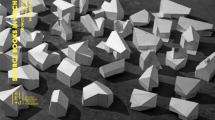Abstract
The idea of Geologic Architecture experienced in these occasions suggests a procedure that not only goes beyond the idea of work autonomous from its context, since it is composed of stratification and the juxtaposition of materials and sections, but also eliminates the boundary between background and object. Each transformation is a node connecting different materials and levels, stratifications of the Earth's crust and human communities, long durations and short times, and cyclic and unique, unrepeatable events. The opposition between nature and artifice disappears and new hybrid matter appears in which boundaries are no longer identifiable, and we are immersed in a hyper-natural environment. The forms of architecture, rather than mere technology, become a response to environmental issues. Even the idea of circularity is bent and reinterpreted within a temporal framework in which instants and long durations are intertwined.
Nature is the maker. It is the giver of presences. You can have a thought, but a thought has not presence until you call on Nature to exercise its powers of order to make it manifest (…) Material is spent light you're spent light, the trees are spent light, the atmosphere is spent light, water is spent light. All material is spent light.
Louis I. Kahn
Access this chapter
Tax calculation will be finalised at checkout
Purchases are for personal use only
Similar content being viewed by others
Notes
- 1.
Richard Saul (1986, p. 29).
- 2.
Aldo (1963, p. 11).
- 3.
Ibidem, p. 9.
- 4.
Ivi, p. 10.
- 5.
De Manuel (2003, pp. 57–58).
- 6.
“Zeno does not pose here the question of the transit, but the question of the figure. The latter is always still unfaithful. The journey here does not go from one point to another, but down the steps of a ladder. It piles the cards on top of each other in a space of overlapping sheets. He searches for the limit of what can be represented, he searches for the real in the recesses of a fragment. (…) Let us suppose that, of a region of space, we possess several maps of different scales; let us arrange them one on top of the other in a volume of several sheets. Zeno does not follow several directions and senses along one of these maps, but descends normally to the successive sheets, pierces a piece in the thickness of the representations. The resumption, the reiteration of his turn, actually concatenates the succession, he draws an exact series. And he descends infinitely towards the room. His path connects the stairs”. Michel (1984, pp. 120–121).
References
Sestini Aldo (1963) Il Paesaggio. Touring club, Milano
De Landa Manuel (2003) Mille anni di storia non lineare. Rocce, germi e parole, Instar libri, Torino
Serres Michel (1984) Passaggio a Nord-Ovest. Hermès V, Pratiche editrice, Parma
Wurman Richard Saul (1986) What will be has always been. The words of Louis I. Kahn, Access and Rizzoli, New York
Author information
Authors and Affiliations
Corresponding author
Editor information
Editors and Affiliations
Rights and permissions
Copyright information
© 2024 The Author(s), under exclusive license to Springer Nature Switzerland AG
About this chapter
Cite this chapter
Navarra, M. (2024). Geologic Architecture. In: Agnoletti, M., Dobričič, S., Matteini, T., Palerm, J.M. (eds) Cultivating Continuity of the European Landscape. Environmental History, vol 15. Springer, Cham. https://doi.org/10.1007/978-3-031-25713-1_23
Download citation
DOI: https://doi.org/10.1007/978-3-031-25713-1_23
Published:
Publisher Name: Springer, Cham
Print ISBN: 978-3-031-25712-4
Online ISBN: 978-3-031-25713-1
eBook Packages: Earth and Environmental ScienceEarth and Environmental Science (R0)




